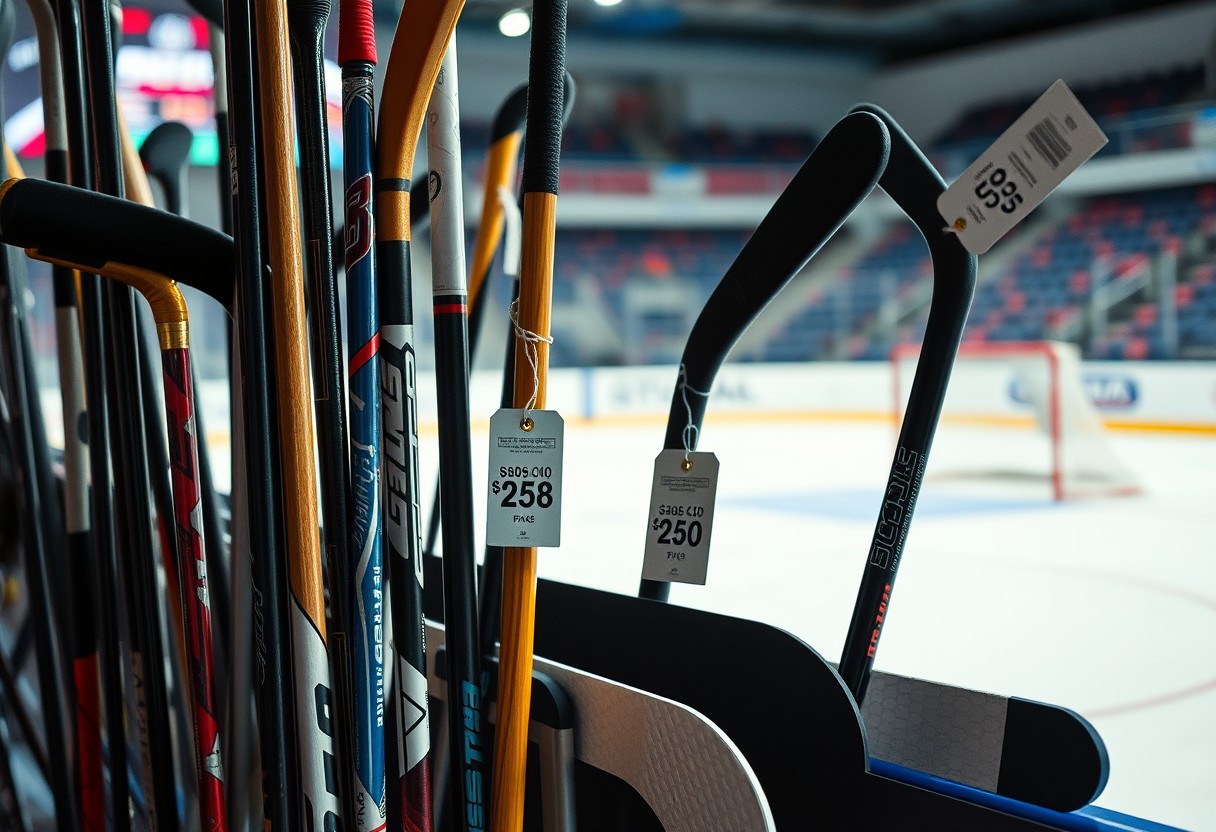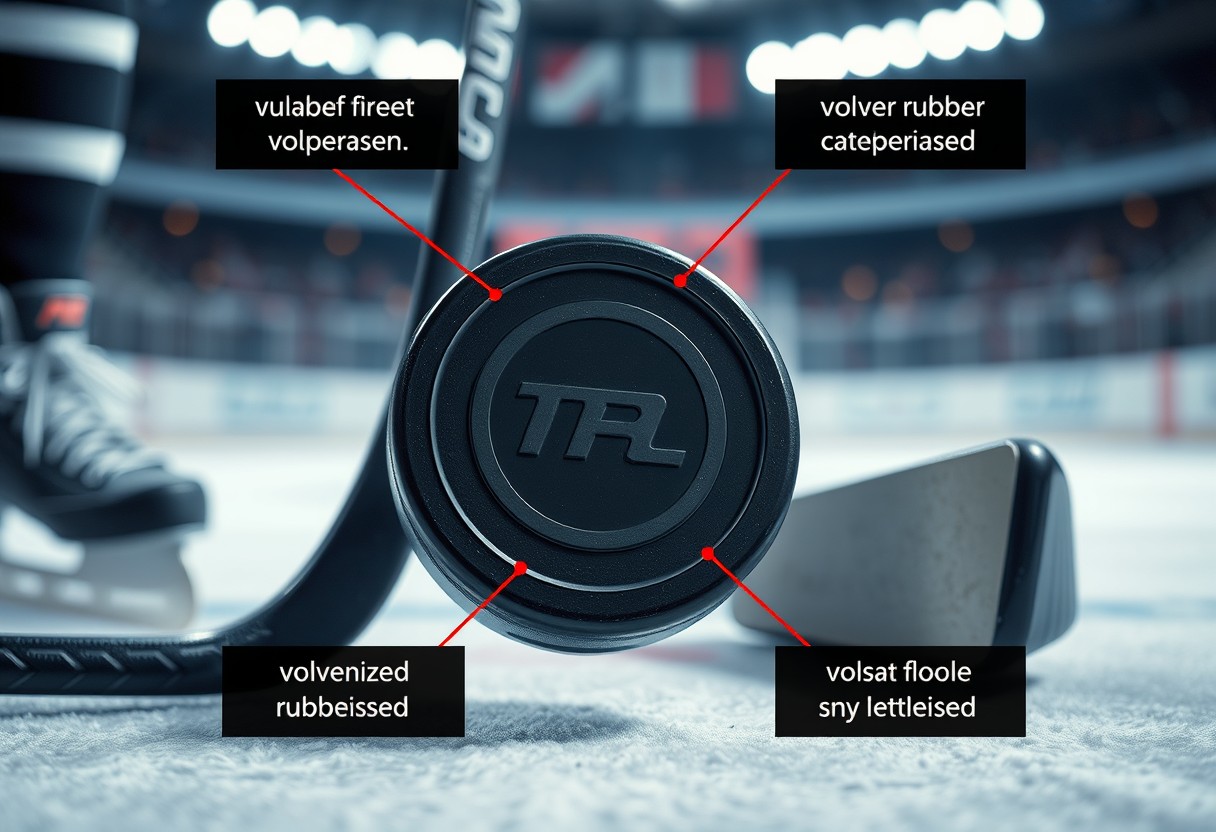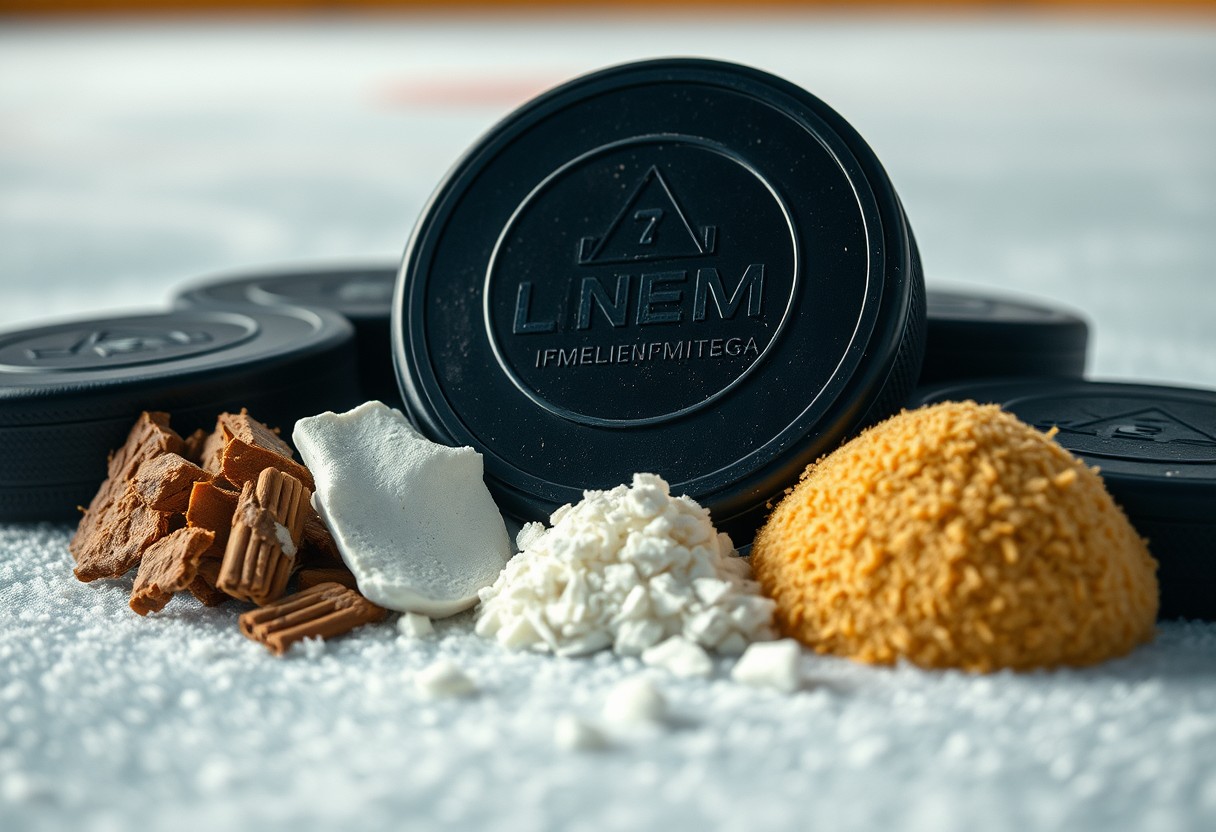Many aspiring hockey players wonder about the cost of a hockey stick as they navigate their journey in the sport. Understanding the price range can help you make an informed decision about what type of stick suits your needs and budget. From beginner-friendly models to professional-grade options, the variety in pricing can often be overwhelming. In this post, you’ll find comprehensive insights into the factors that affect hockey stick prices, enabling you to choose the right equipment for your game without overspending.
Key Takeaways:
- Price Range: The cost of a hockey stick can vary significantly, typically ranging from $30 to $300 depending on the brand, material, and technology used.
- Material Matters: Higher-end sticks are often made from composite materials which provide better performance and durability compared to wooden sticks.
- Player Type: Selecting the right stick should be based on the player’s skill level and position, as sticks are designed to cater to different playing styles for optimal performance.
Understanding Hockey Stick Pricing
Before making a decision on which hockey stick to purchase, it’s imperative to understand the various factors influencing pricing in the market. The cost of a hockey stick can range significantly, from budget options to premium models, depending on a multitude of elements. Knowing what these are will help you choose a stick that fits your gameplay style and financial considerations.
Factors Influencing Price
With a wide range of hockey sticks available, there are key factors that influence their pricing. Here are some of the primary considerations:
- Material Quality: Higher quality materials can lead to higher performance and durability.
- Manufacturing Techniques: Advanced technology in manufacturing can increase the cost.
- Brand Reputation: Established brands often charge more due to their history and customer loyalty.
- Player Level: Sticks aimed at professional players usually come at a higher price point.
- Length and Flexibility: Specific measurements and flex ratings can affect pricing.
Assume that you are investing in a stick that will enhance your playing experience; understanding these factors will empower you to make an informed choice.
Material Composition
Influencing the quality and performance of hockey sticks, material composition plays a crucial role in their pricing. Generally, sticks are made from composite materials, wood, or a combination of both. Composite sticks, often made from carbon fiber, provide better performance in terms of weight, strength, and responsiveness compared to wooden options.
A primary reason for the pricing differences lies in the materials used. For example, a stick made entirely from high-grade carbon fiber will typically cost more than one that combines different materials. This is because advanced composites improve the stick’s strength-to-weight ratio, while also providing superior energy transfer and reduction in vibrations during gameplay, leading to better puck handling and shooting accuracy.
Brand Differences
Influencing your purchasing decision, brand differences can create noticeable disparities in hockey stick pricing. Well-known brands that have a longstanding reputation in the hockey community often charge a premium for their products. They invest heavily in research and development to improve the performance and durability of their sticks, which in most cases justifies the increased costs. Additionally, recognizable brands usually have more effective marketing strategies and endorsements from professional players, further elevating their status among consumers.
The possibility of a high price tag doesn’t always guarantee superior quality, so it’s imperative to evaluate the differences in the features offered by various brands. Some lesser-known brands may produce excellent quality sticks at lower prices, focusing on specific niches or player levels. Understanding your own playing style and needs will allow you to find a brand that does not just appeal to your budget but also complements your game.
Technology and Features
The advent of technology has transformed the way hockey sticks are designed and manufactured, resulting in a broad range of prices. Advanced features including improved blade technology, enhanced shaft construction, and specialized grip designs contribute to the overall cost of a stick. These enhancements aim to provide optimal performance, whether it’s for shooting accuracy, puck control, or overall game playability.
Features such as low kick points for quick release, and multi-layered construction for strength and flexibility can significantly influence the pricing of a hockey stick. Modern sticks often come equipped with features designed for specific types of players, such as forwards versus defensemen, further adding to the complexity of pricing.
Features like these can substantially elevate the price of a hockey stick. So, when selecting your ideal stick, consider the various technological advancements and features that suit your level of play so you can make an investment that meets your needs.
Types of Hockey Sticks
Clearly, understanding the different types of hockey sticks available on the market is crucial when you are making your purchase decision. Each type of stick is designed with specific materials and features that cater to various playing styles and preferences. Here’s a breakdown of the main types of hockey sticks:
- Wooden Sticks
- Composite Sticks
- Specialty Sticks
- Youth Sticks
- Adult Sticks
Knowing the characteristics and benefits of each type will help you choose the right stick tailored to your skill level and playing style.
| Wooden Sticks | Traditional, durable, less expensive |
| Composite Sticks | Lightweight, flexible, higher performance |
| Specialty Sticks | Designed for specific purposes, such as street hockey or goaltending |
| Youth Sticks | Shorter and more lightweight, suitable for younger players |
| Adult Sticks | Longer and made for advanced play, stronger materials |
Wooden Sticks
With a long history in hockey, wooden sticks remain a popular choice, especially for beginners and casual players. These sticks are typically made from laminated wood and offer a solid feel when handling the puck. One of the main advantages of wooden sticks is affordability, making them accessible for players who are just getting started.
Wooden sticks can also have a considerable degree of durability, but they’re generally heavier than their composite counterparts. They offer a classic feel and some players prefer them over newer materials. However, they may not provide the same level of performance or consistency that advanced players seek.
Composite Sticks
Sticks that are made from composite materials have gained immense popularity in recent years due to their enhanced performance features. These sticks utilize a mix of materials—such as carbon fiber and Kevlar—to create a lightweight and durable product that can greatly improve your game. The elasticity of composite sticks allows for better shot power and accuracy, making them a favorite among advanced players.
Furthermore, composite sticks often come with varying flex ratings, allowing you to customize your stick based on your shooting style and preferences. The improved technology in these sticks also contributes to their higher price point compared to wooden sticks, but many players find the investment worthwhile for the performance benefits.
For instance, many advanced players report that their shot velocity and control have significantly improved since switching to a composite stick, further validating the advantages this type of equipment can provide.
Specialty Sticks
An increasing number of specialty sticks are being developed to address specific demands in the game. These include options crafted specifically for street hockey, goaltending, or even women’s play. Each specialty stick is designed to maximize performance in its intended context, ensuring you have the right tools when you need them the most.
Some players may find that a specialty stick enhances their gameplay and allows them to explore different formats of the sport that a standard stick cannot accommodate. Whether you’re looking to dominate your street hockey league or enhance your goaltending skills, there are specialized options available to fit your needs.
Hockey aficionados often look for specialty sticks to gain a competitive edge, as these specific designs can offer unique handles, blade shapes, and materials tailored for various playing conditions, making gameplay more enjoyable and effective.
Youth vs. Adult Sticks
On the other end of the spectrum, youth and adult sticks vary significantly in size and weight to cater to the physical attributes of different age groups. Youth sticks are generally lighter and shorter, making them easier for young players to handle and control. The flexibility and lightweight design of youth sticks help promote proper technique and skill development as your child learns the game.
Conversely, adult sticks are designed to accommodate the strength and skill level of more experienced players. They tend to be longer and made from stronger materials, capable of withstanding the penultimate levels of play without compromising performance. As you make your decision, it is crucial to select a stick that corresponds with your player’s growth and playing stage.
Specialty youth sticks exist as well, designed with unique features to enhance the learning experience for younger athletes. From flexibility to grip design, these sticks can help foster a love for the sport while setting the foundation for future improvement.
Price Ranges
To understand the market for hockey sticks, it’s vital to break down the price ranges available. Hockey sticks typically fall into four main categories: entry-level, mid-range, high-end, and custom sticks. Each category offers different features and benefits that cater to various skill levels and budgets. By being informed about these ranges, you can make a better decision on which hockey stick fits your needs and financial capacity.
Entry-Level Sticks
Sticks in the entry-level category are designed for beginners or casual players. These models generally range from $30 to $70, and they offer a balance of affordability and functionality. While they might not have the latest technology or advanced materials, entry-level sticks provide a decent playing experience for those just starting out or for players who play recreationally.
Choosing an entry-level stick allows you to focus on developing your skills without making a significant investment. As you practice and improve your game, you can consider upgrading to a higher-end model that better suits your evolving playstyle and needs.
Mid-Range Sticks
On the other hand, mid-range sticks are perfect for more experienced players looking for enhanced performance. You can expect to pay between $70 and $150 for these sticks, which often incorporate better materials and technologies than their entry-level counterparts. Mid-range sticks typically feature improved flex patterns and better balance, allowing for more accurate shooting and better puck control.
Price-wise, mid-range sticks bridge the gap between entry-level and high-end models. They represent a solid investment for players who are serious about their game but may not yet require the cutting-edge performance of high-end sticks. With this category, you gain access to a more refined playing experience without the hefty price tag that comes with premium models.
High-End Sticks
High-end sticks are designed for competitive players and professionals, and they can range from $150 to $300 or more. HighEnd sticks are crafted using high-quality materials, such as advanced carbon fiber, which provides excellent grip, lightweight construction, and superior responsiveness. In this price category, you will find sticks that are engineered for maximum performance and durability, making them the preferred choice for serious athletes.
The advantages of high-end sticks are not limited to performance alone; they also offer additional customization options, allowing you to tailor the stick to your unique preferences. This could include adjustments in flex, shaft length, or blade pattern, enhancing your overall playing experience.
Custom Sticks
On top of the standard options, custom sticks provide the ultimate in personalization. This category can range from $250 to over $500, depending on the complexity and specifications you choose. Custom sticks are crafted to suit your individual playing style, preferences, and physical attributes, ensuring that you have a stick that feels just right for you on the ice.
Sticks designed specifically for you can improve your game in significant ways. By investing in a custom stick, you’re not only ensuring that the stick responds well to your playing style but also enhancing comfort and reducing the risk of injury, as the stick is tailored specifically to your measurements.
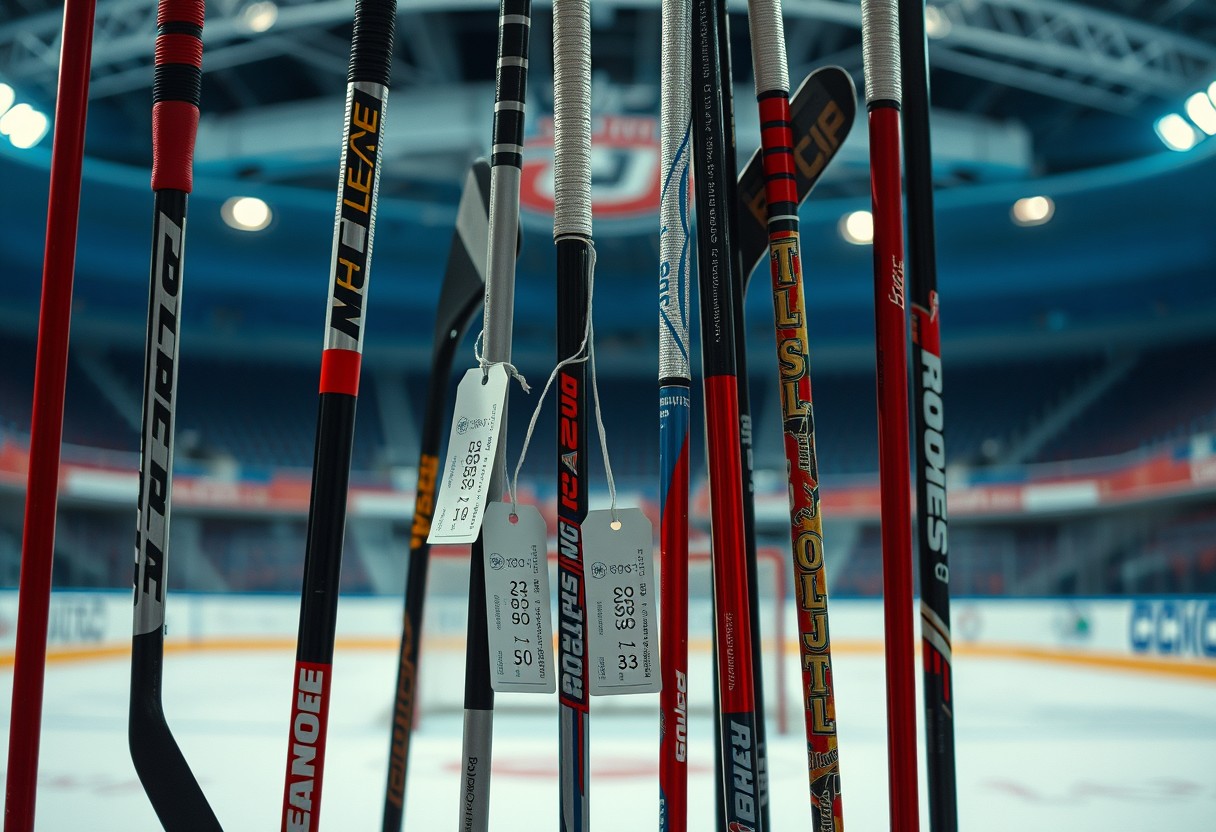
Where to Buy Hockey Sticks
Many aspiring hockey players often wonder where they can purchase the ideal hockey stick to enhance their game. Fortunately, there are various options available, ranging from local retail outlets to specialized shops and online platforms. Your choice will depend on your personal preferences, budget, and convenience.
Retail Stores
Stores in your local area, such as sporting goods retailers, can be a great starting point for buying hockey sticks. These brick-and-mortar locations typically carry a decent selection of models and brands, allowing you to physically hold and evaluate the sticks before making a purchase. This is particularly beneficial because you can gauge the weight, flex, and overall feel. Additionally, these stores often have knowledgeable staff who can help you select a stick that suits your playing style and skill level.
Many of these retail stores also offer sales during the off-season or clearance events, providing you the opportunity to snag a quality hockey stick at a fraction of the original price. If you choose to shop locally, be sure to check multiple stores to compare prices and selections, ensuring you find the best deal possible.
Online Marketplaces
Any savvy shopper knows that online marketplaces can provide a vast array of hockey stick options right from the comfort of your home. Websites like Amazon, eBay, and specialized sports retailers can offer competitive pricing and a wider selection than most retail stores. This makes it easier for you to compare different brands, models, and prices, ultimately leading to an informed purchase decision.
Another advantage of shopping through online marketplaces is the availability of customer reviews and product ratings. By reading through the experiences of other buyers, you can gain valuable insights into the performance and quality of the hockey sticks you are considering, ensuring that you make a well-informed choice that aligns with your needs.
Specialist Hockey Shops
Sticks specifically made for hockey can often be found at specialist hockey shops, which cater exclusively to the needs of players and enthusiasts. These shops tend to have a more informed staff who can provide you with tailored advice, helping you find the perfect stick based on your skill level and playing style. Not only do they stock various brands and models, but they may also have unique items that are harder to find at larger retail stores.
Retail specialists frequently offer fitting services, allowing you to test sticks on-site. Some even offer custom ordering options for those looking to personalize their gear. Overall, shopping at a specialist shop can elevate your buying experience and ensure that you leave with a stick that truly suits your game.
Second-Hand Options
Hockey enthusiasts on a budget can explore second-hand options, which often provide quality sticks at a fraction of the original price. Thrift stores, local sports exchanges, or online classifieds can be excellent resources for finding used equipment. When purchasing second-hand, you can often score deals on high-end sticks that still have plenty of life left in them, making this an economical choice for many players.
For instance, platforms like Facebook Marketplace or Craigslist often have listings for gently used hockey sticks, allowing you to negotiate prices directly with sellers. Always remember to inspect the stick for signs of wear and damage to ensure that it will perform well on the ice. Buying second-hand can not only save you money but also support sustainability by giving equipment a second life.
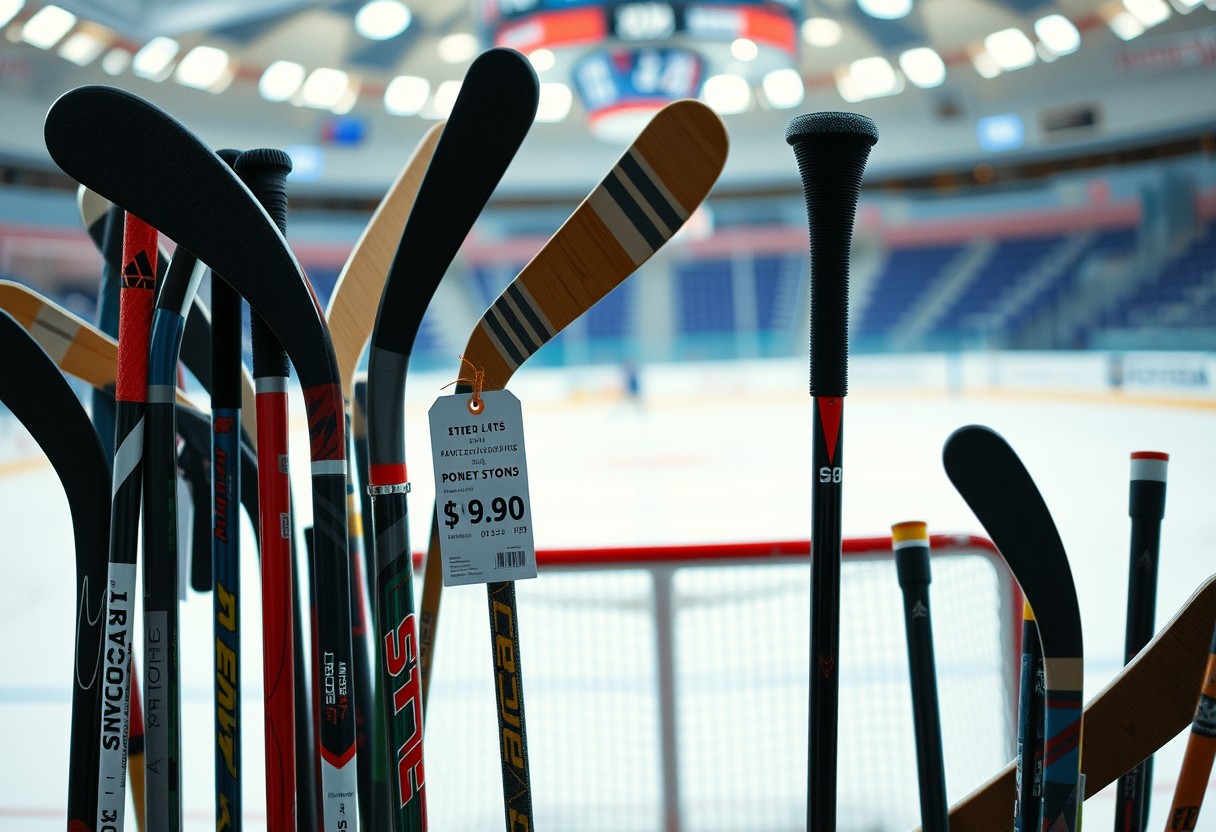
Maintenance and Longevity
Now, keeping your hockey stick in top condition is vital for maximizing its performance and lifespan. Regular maintenance not only ensures that your stick performs at its best but also prevents the need for premature replacements. Understanding the care required for different types of sticks—wood and composite—can significantly affect their durability and how long they serve you on the ice.
Care Tips for Wood Sticks
Maintenance for wood sticks necessitates a bit more attention compared to composites. Wood is a natural material that can absorb moisture and can be susceptible to splitting if not cared for. Here are some care tips to extend the life of your wood stick:
- Avoid leaving your stick in damp conditions or extreme temperatures.
- Regularly check for cracks or splinters and sand them down if needed.
- Keep your stick covered in protective sleeves when not in use.
Recognizing the unique needs of wood sticks will help you maintain their integrity and ensure they last for multiple seasons.
Care Tips for Composite Sticks
Composite sticks are designed for high performance, but they still require specific care to maximize their longevity. One of the main factors to consider with composite sticks is their vulnerability to impact damage. Here are some tips to maintain your composite stick:
- Avoid using your stick for unintended purposes, like stickhandling off the ice.
- Store your stick in a cool, dry place, away from direct sunlight.
- Inspect your stick frequently for scratches and dents.
Any neglect can cause your composite stick to underperform and shorten its lifespan.
Additionally, be mindful of how you handle your stick during practices and games. Avoid hitting the ice or boards with the blade, as this can cause significant damage over time. Be mindful of, proper treatment pays off.
- Regularly tape the blade to protect it from chips.
- Use a protective cover when transporting your stick.
- Pay attention to the feel of your stick; any change might indicate a developing issue.
Any proactive measures can make a considerable difference in durability.
Signs of Wear and Tear
Care guidelines are crucial, but it’s equally important to know the signs of wear and tear on your hockey stick. The most common indicators include visible cracks and reduced responsiveness when shooting or passing. If you notice these signs, it may be time to reconsider your stick’s viability on the ice.
With consistent play, wear on your stick is inevitable. However, addressing these signs early can prevent a sudden break during an important game. Look out for dull blades, rattling sounds, or unusual bends in the shaft, as these can signal the need for repair or replacement.
How to Extend the Life of Your Stick
Life is all about prevention when it comes to hockey stick maintenance. By routinely checking for damage and storing your stick properly, you can significantly extend its useful lifespan. A little bit of effort goes a long way in ensuring that your stick remains reliable during your games.
Sticks are not just expensive investments but vital tools for your performance on the ice. Regular upkeep, combined with attention to detail regarding their condition, helps secure that you get the most out of your equipment for the duration of its use. Be mindful of, a well-maintained stick can elevate your game and enhance your overall experience on the ice.
User Reviews and Recommendations
Once again, understanding the cost associated with hockey sticks is greatly enhanced by user reviews and recommendations. These insights offer a valuable perspective on not only the performance of various models but also their long-term durability and whether they deliver good value for the price. Whether you are a professional player or just starting, hearing from others can help you determine what to invest in for your specific playing style and skill level.
Professional Player Insights
To gain a deeper understanding of the high-performance hockey sticks available in the market, insights from professional players can be immensely beneficial. Many professional players often provide detailed reviews based on their firsthand experience with specific sticks, discussing aspects such as flexibility, grip, weight, and overall balance. This feedback can serve as a guiding light in making an informed decision about which stick might best complement your advanced technique and competitive style.
To further assist in your selection process, professional recommendations often highlight advanced materials and technologies that enhance performance on the ice. These insights not only focus on the stick’s capabilities but also discuss how they withstand the rigors of professional play, making them a worthwhile investment for serious athletes looking to improve their game.
Amateur Player Experiences
Reviews from amateur players provide an invaluable perspective when choosing a hockey stick, especially if you’re still developing your skills. Many amateurs share their experiences with various brands and models, detailing how specific sticks have contributed to their growth in the sport. From lightweight options that facilitate better handling to more robust sticks that can withstand beginner-level play, these reviews can help you pinpoint what features may be imperative for your individual needs.
Amateur players typically appreciate sticks that offer a balance of quality and affordability. You’ll find that many players recommend certain models that may not be the most expensive but deliver excellent performance for entry to intermediate levels. Features like a good flex rate and proper grip often come up as factors they value, allowing for better control and shooting accuracy as they hone their skills.
Best Sticks for Beginners
Recommendations for the best sticks for beginners typically emphasize affordability without sacrificing quality. When starting, it is imperative to choose a stick that is durable and well-suited to your skill level, allowing room for improvement as you progress. Look for sticks that offer a good combination of weight and balance, making it easier for you to develop proper shooting technique and puck handling without being hindered by an overly heavy or complex stick.
Player experiences suggest that many beginners benefit from sticks that include features like a lower kick point for quicker release shots, which can be advantageous for budding players aiming to enhance their goal-scoring abilities. Furthermore, some beginners have reported positive experiences with composite sticks that provide an excellent resonance of strength and lightweight construction, helping establish the foundational skills necessary for growth in the sport.
Recommendations by Age Group
Group recommendations offer valuable insights into what type of stick may be most appropriate for your age and skill set. Youth sticks are often designed with flexible shafts that can enhance control and assist with accuracy as young players develop their technique. As you transition into adulthood or higher levels of play, you may want to explore sticks that offer greater durability and performance, taking into account your physical development and playing style.
The recommendations vary significantly depending on the needs of different age groups, with younger players often benefiting from lighter sticks that allow for easier handling, while older or more experienced players might prioritize power and shot performance. As you consider which hockey stick is best for you, remember that these age group recommendations should serve as a helpful guideline to facilitate your decision-making process.
Final Words
Now that you have a clearer understanding of how much a hockey stick can cost, it’s important to consider the factors that play into the price point. Your budget will ultimately dictate the options available to you, whether you’re a beginner looking for an affordable stick or a seasoned player ready to invest in a top-of-the-line model. Remember to evaluate not just the initial cost, but also the quality and durability of the stick, as these factors can significantly impact your performance on the ice and how long the equipment will serve you well.
Additionally, don’t overlook the value of fitting your hockey stick to your personal playing style and skill level. Exploring various brands and models can help you find a stick that not only fits your budget but also enhances your game. Keep in mind that investing in a well-suited hockey stick can lead to better performance and an improved overall experience on the ice. So, as you make your decision, weigh all aspects carefully to ensure that you choose the right stick that aligns with your playing needs and financial considerations.

